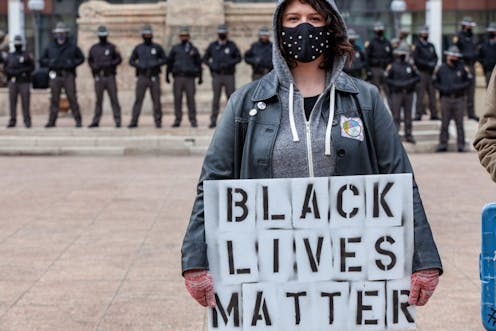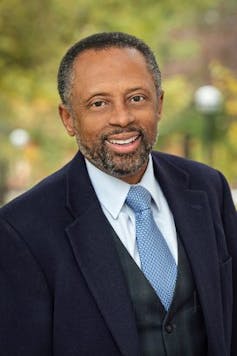Social accounting includes looking beyond the bare numbers of racial diversity
Two leaders in academia weigh in how numbers and statistics can enforce institutional racism.

Editor’s note: From time to time, The Conversation asks leaders in America’s colleges and universities to address some of the most pressing issues in our nation. Here we ask Earl Lewis, director and founder of the University of Michigan’s Center for Social Solutions, and Nancy Cantor, chancellor of Rutgers University – Newark, a diverse, urban public research university, about how numbers and statistics matter when examining institutional racism, the Capitol riot and Black Lives Matter.
How has media reporting on numbers and statistics affected the public’s view of race?

Nancy Cantor: Society’s accounting of the summer of 2020 through Inauguration Day 2021 demonstrates the hard way numbers play into a long-standing history of racism and white privilege. Some national leaders equated a crowd of mostly white Capitol Hill rioters to largely peaceful Black Lives Matter protests. Yet analyses show that the overall levels of violence and property destruction during BLM protests were low, and most of the violence that did take place was, in fact, directed against the BLM protesters. When it is convenient for media or leaders to compare the crowd to the few, they can also evoke long-standing racist tropes, such as “the violent Black.”

Earl Lewis: “How to Lie with Statistics,” the all-time best-seller in the field, was published more than a half-century ago, but never has that saying felt weightier than today. The twisting of data to draw a false equivalency between the assault on the Capitol and BLM protesters offers a stark reminder of how numbers make a consequential contribution to the ways the country understands its history, memory, power, privilege and position.
Not only does racism enable lying with statistics in these vivid public events, but even more perniciously in everyday life. A classic example comes from Claude Steele’s book “Whistling Vivaldi” in which a young Black man learns a Vivaldi tune to whistle when he walks down the street so he can reassure white passersby that he is not a threat. The takeaway: “I know Vivaldi. I am me. Let me be me. I am safe and not a threat.” This is especially poignant in a landscape where demographic changes, referred to by demographer William Frey as the “diversity explosion,” foretell the end of a white numerical majority and threaten the dominance of white privilege.
How can numbers perpetuate racism? inclusion?
Earl Lewis: For the past four or so decades, in our so-called “colorblind” society, the dominant white majority has been just fine endorsing “diversity,” as long as what we mean by that is only a relatively modest shift in numbers. As such, the inclusion in classrooms, boardrooms, lunchrooms and the halls of Congress pertains mainly to those “exceptional” (read few) candidates who “rise above adversity” to excel, continuing a tradition of minority status, though barely making a dent in the implicit perceptions of their group writ large.
In this tradition, as well-earned and hard-won as are the seats of the first Black and the first Jewish Georgia senators elected recently – clearly shifting if not threatening the dominant electoral presumptions – one can only keep looking to the day when the table itself is reset to actually represent the demographics and full talent pool of our full country.
Nancy Cantor: Numbers matter not just, though importantly, in their power to threaten privilege, but more positively because of the freedom they can bestow. That is, freedom from the burden of “representation” – being forcibly cast in the role of representing one’s entire group, with the stereotype threat it entails, with all its historical baggage. For example, no longer is the sole Black woman ascending to a new position forced to be a stereotype of excelling among adversity and carry all the historical baggage that entails.
Progress will come, then, when previously and currently dominated, excluded, denigrated groups can actually be accorded the “comfort in numbers” taken so for granted by those in power and in the majority.
Are solutions visible?
Nancy Cantor: There is promise in numbers, when accompanied by the hard work such as the relentless voter registration to counter voter suppression to build a new more representative and diverse map in Georgia on the ground. This is one step closer to the real count – one that more rightfully lets everyone count.
So as we complete our autopsies of the waning days of the Trump administration, let’s make sure we center the role and place of numbers. Numbers can fuel lies and encourage destruction, or they can be used to guide a healthy, inclusive, forward-looking democracy.
Earl Lewis: Numbers are not in any way a panacea for true inclusion, but they certainly are a necessary first step. Numbers won’t alleviate the need for the hard work of building inclusive environments that actually empower a “diversity bonus,” as systems theorist Scott Page demonstrates when diverse groups bring diverse lived experience and insights to bear on all the hard problems of our world. But numbers might get us to what the late organizational theorist Katherine Phillips dreamed of – that is, a time when we spend less time defending the value of diversity while we sit comfortably reinforcing homogeneity.
The authors do not work for, consult, own shares in or receive funding from any company or organization that would benefit from this article, and have disclosed no relevant affiliations beyond their academic appointment.
Read These Next
How rogue nations are capitalizing on gaps in crypto regulation to finance weapons programs
North Korea was behind a $1.5 billion digital bank heist in February 2025. Other countries are similarly…
A, B, C or D – grades might not say all that much about what students are actually learning
Grades can magnify inequities that exist in American schools, making it harder for some students to…
Gazing into the mind’s eye with mice – how neuroscientists are seeing human vision more clearly
It was once believed that mice had relatively poor vision. Turns out mice are far from blind – and…






